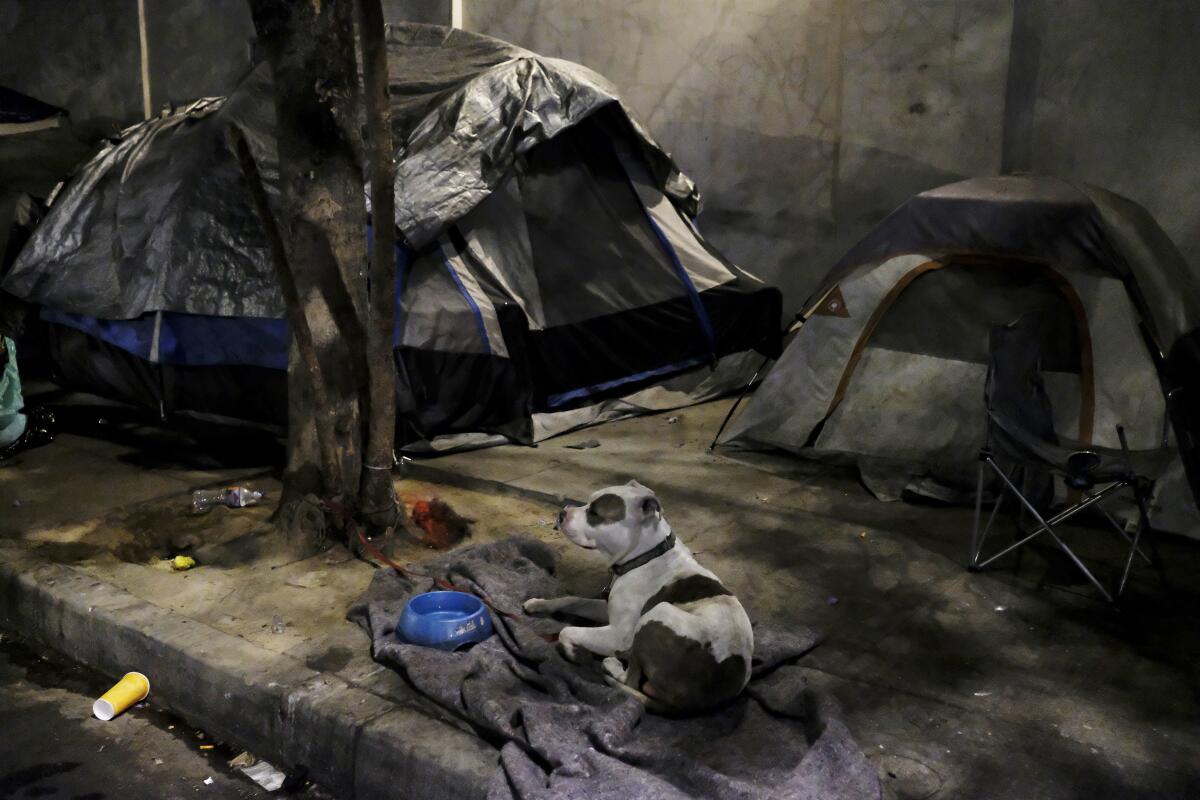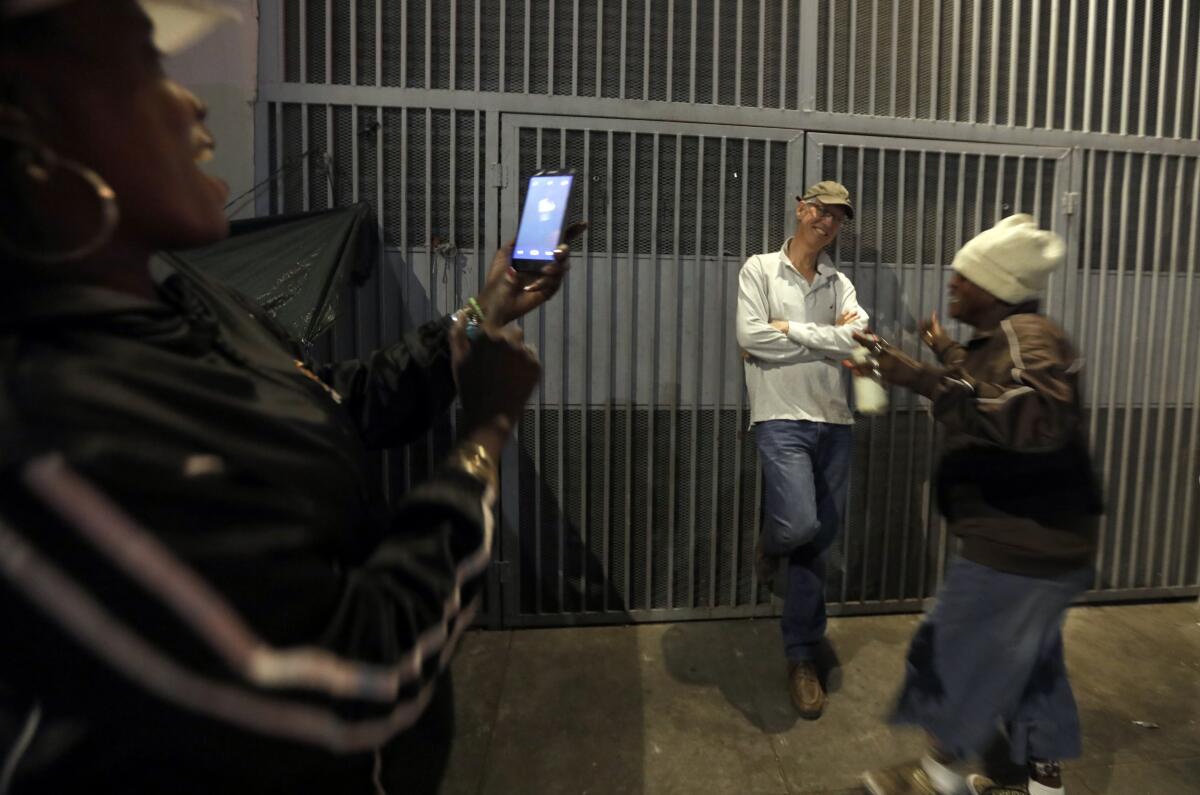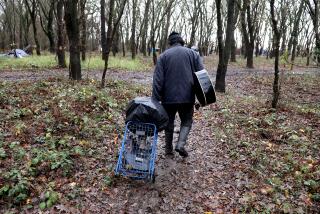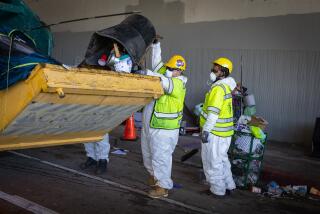Newsletter: Behind the scenes on a yearlong homelessness reporting project

Good morning, and welcome to the Essential California newsletter. It’s Thursday, Aug. 15, and I’m writing from Los Angeles.
Get the Essential California newsletter »
When I tell people I am a reporter in Los Angeles, there is a single question that comes up more often than any other. Regardless of where I am or whom I am talking to, people almost always end up asking the same thing: Why is homelessness so bad here?
I can rattle off a boilerplate answer that outlines the basics. But somehow — despite having written about the topic over the years, and having spent plenty of time both reading policy analyses and talking to people personally affected — I always feel slightly unprepared to address the magnitude of it, or really to get at just what exactly has made this crisis so intractable.
[See also: “Why L.A. County’s homelessness crisis has been decades in the making” in the Los Angeles Times]
Two of my colleagues, writer Thomas Curwen and photographer Francine Orr, have spent more than a year documenting the lives of seven homeless individuals selected by city and county agencies for a special program to be relocated from their encampment into new apartments seven miles away.
“The Street Within,” the resulting four-part series, comes closer to fully answering that thorny question than anything I have ever read.
It is, of course, not a simple answer, but rather one composed of small and large tragedies, bureaucracy, roadblocks, the best of intentions and the unruliness of human lives. Read it here:
Part One: “After years of tent fires and city sweeps, Big Mama needed a home. But it wasn’t that easy”
Part Two: “Broadway Place’s homeless residents were promised homes. Had the city forgotten them?”
Part Three: “An entire L.A. homeless encampment moved into apartments. But their past still found them”
Part Four: “When L.A. moved them off the streets, some knew it was their last chance. Others didn’t see it that way”
Behind the story: Linger among tents on city streets and the quick assumptions about homelessness fall away.
You should read this story if you live in Los Angeles or care about Los Angeles. You should read it if think you already understand the homelessness crisis here, or if you’ve felt helpless at wrapping your head around the hows and whys of so many people suffering in our streets.
I asked Thomas a few questions about his reporting and the process behind the story. Here’s part of our conversation:
There are nearly 59,000 people in L.A. County experiencing homelessness. How did you choose these seven individuals to focus on?
In January 2018, my editor asked me to look into homeless crisis and see if there was something that had been missed in our coverage. I was new to the beat and had long admired the excellent work being done by my colleagues. I was skeptical that I would have much to add. Then one day, I walked from Times Mirror Square into skid row, where administrators for the Los Angeles Homeless Services Authority had their offices. I’ll never forget how surreal, how Dickensian, this city seemed that afternoon.
That afternoon at LAHSA, I learned about a program that the United Way was about to roll out that would focus on homeless encampments in two neighborhoods in South L.A., and about a week later, I was in the field with outreach workers as they moved from tent to tent near Broadway Place and 39th Street.
I was lucky to have Times photographer Francine Orr assigned to the story. Francine has been reporting on homelessness for more than 10 years, and together we met Big Mama, who served as our introduction to this stretch of sidewalk. Soon we had buy-in from most of her neighbors.
Can you tell us about the reporting process for this series?
Francine and I made a point of visiting the encampment at least once a week. We wanted everyone to become comfortable with us. We wanted them to let down their guard and to speak with us candidly about their lives and the daily struggles. We tried to mix up the times that we stopped at well, sometimes in the mornings, sometimes in the evenings, on weekdays and weekends. By mixing it up, we were able to get a more realistic picture of their lives, 24/7.
And I think we succeeded, capturing first-hand the challenges they faced — when a car jumped the curb and ran into the tents, when a heat wave took the life of Caesar the pit bull, when the city’s sanitation department conducted their periodic cleaning sweeps. Not only was there the drama, but there were quiet moments as well. Francine has a word for this reporting — she calls it “lingering” — and that’s a good way to think about our work and the hours we spend sitting with everyone, talking and listening, seeing what would develop.

This series is written with a great deal of intimacy. Whenever I read a story like this, I’m curious about the reporter-subject relationship, and whether it extended beyond the typical bounds. What did it look like for you and Francine?
There are news stories about homelessness, there are policy stories about homelessness, and there are profiles of homeless. All are excellent and important, but Francine and I worried that readers were fatigued by the coverage of an issue that seemed so intractable. We instead wanted to get as close to the experience of homelessness as possible, which of course brought us closer to the people we were reporting on.
So yes, it becomes a challenge to keep a distance and maintain objectivity and at the same time get close to their lives. The people of Broadway Place opened up their worlds to us, and it’s natural that we wanted to reciprocate somehow, show them our appreciation. But there was a limit to what we could do. I would occasionally bring water and M&Ms and variety packs of potato chips to the encampment, but that was the extent of it. When we were asked for money, we declined. It is a balancing act, creating an environment that allows people to open up to us and at the same time making sure our work isn’t compromised by our relationship to them.
What surprised you most?
When Francine and I began reporting The Street Within, one of our goals was to document the challenges of getting homeless individuals off the street and into housing. I think many people — readers, citizens of L.A. — wonder why this problem is so overwhelming, and it was important for us to show the roadblocks and bureaucratic impediments to the process. The forms, the signatures, the background checks, the sheer amount of paperwork was staggering, and the numbers of people behind the scenes working to get the homeless housed is impressive.
But what became even more interesting was to realize that housing doesn’t end the problems associated with homelessness. In fact, housing the homeless — as vexing an issue as that is — is almost easy, compared to helping the homeless stay housed.
As we followed the people who lived on Broadway Place into housing and saw the habits and behaviors of the street follow them indoors, we realized that solving the homeless crisis in Los Angeles will take years, if not decades, of the city’s commitment to the problem. Housing is critical, but housing alone is merely a Band-Aid to the issues that forced these individuals to the streets in the first place.
And now, here’s what’s happening across California:
TOP STORIES
In a Kafkaesque turn of events, the Los Angeles County Sheriff’s Department top watchdog is under investigation — by the Sheriff’s Department. The Sheriff’s Department launched a criminal investigation into its chief watchdog tied to allegations that the oversight agency unlawfully obtained internal records. The move by the Sheriff’s Department drew swift condemnation from county Supervisor Sheila Kuehl, who said the inquiry “smells a little bogus.” The investigation is the latest episode in a clash over how much access the watchdog organization should have as part of its role in monitoring the Sheriff’s Department. Los Angeles Times
L.A. STORIES
The Los Angeles County Board of Supervisors voted to cancel a $1.7-billion contract for a downtown mental health treatment center to replace Men’s Central Jail. Supervisor Hilda Solis said the board’s vision required a new set of experts ready to employ a health-centered approach. Los Angeles Daily News
Why Plácido Domingo’s response to sexual harassment allegations is drawing heavy fire. Los Angeles Times
Is gentrification making West Hollywood less gay? LAist
Republican John Lee claimed victory in a special election for a San Fernando Valley seat on L.A. City Council. Los Angeles Times
Stockpiling pastrami and doubling staff, L.A. businesses prepare for “Maisel Day,” with 1950s-inspired prices hitting nearly 30 businesses on Thursday as part of Amazon’s Emmy campaign for “The Marvelous Mrs. Maisel.” Los Angeles Times
Your support helps us deliver the news that matters most. Subscribe to the Los Angeles Times.
IMMIGRATION AND THE BORDER
A federal appeals court appeared likely to let the Trump administration end humanitarian protections for immigrants from Haiti, Sudan, Nicaragua and El Salvador. About 300,000 immigrants from those four countries have been allowed to live and work in the United States with temporary protected status, or TPS. Los Angeles Times
Detainees allege serious medical neglect at the Otay Mesa Detention Center in San Diego. Voice of San Diego
POLITICS AND GOVERNMENT
State legislators blasted PG&E’s aggressive plan to turn off power lines during wildfire-prone weather during a lengthy hearing in Sacramento. Lawmakers contended the utility had not done enough to mitigate the effects of prolonged shutoffs. San Francisco Chronicle
Sacramento City Council has approved a rent control measure that will cap annual rent increases at 6% plus inflation and add other tenant protections. Sacramento Bee
How Rep. Devin Nunes (R-Tulare) turned Twitter parody accounts into political “weapons” — against himself. Fresno Bee
Long Beach’s mayor is a young, openly gay immigrant whose political star is on the rise. Long Beach Press-Telegram
CRIME AND COURTS
The rifle used in a deadly Riverside shooting was an untraceable “ghost gun,” according to law enforcement sources. Los Angeles Times
Fifty-eight inmates were injured during a large riot at a state prison in Soledad. Salinas Californian
HEALTH AND THE ENVIRONMENT
The Ridgecrest earthquakes caused up to $5 billion in damage to China Lake naval base. Los Angeles Times
Federal officials rejected a petition to list Joshua trees as threatened under the Endangered Species Act. (Read our previous newsletter coverage of the Joshua trees’ plight here.) Desert Sun
A suicide inside San Diego’s bustling Central Library has highlighted the library’s role at the center of the region’s mental health and homelessness crises. Voice of San Diego
CALIFORNIA CULTURE
Postmates has received a permit to begin testing an autonomous delivery robot in its hometown of San Francisco. San Francisco Chronicle
The San Francisco school board reversed course on a controversial George Washington mural this week, voting to obscure the art with panels or similar materials rather than painting over it. San Francisco Chronicle
Hippiedom’s place in history in still unsettled, 50 years after the original Woodstock commenced and as “Once Upon a Time ... in Hollywood,” with its hippie-hating lead characters, plays in theaters. Los Angeles Times
Surf’s up in the California desert as wave-pool attractions grow. Wall Street Journal
A putrid-smelling “corpse flower” is expected to make its rare bloom this week in Orange County, and fans are flocking to experience the smell. Orange County Register
CALIFORNIA ALMANAC
Los Angeles: sunny, 85. San Diego: sunny, 78. San Francisco: sunny, 78. San Jose: sunny, 97. Sacramento: sunny, 107. More weather is here.
AND FINALLY
Today’s California memory comes from David Ollier Weber:
“I was a fresh Navy ensign on my way in my new red VW convertible to San Francisco and my first ship, the USS Higbee (DD-806), homeported in Yokosuka, Japan. I’d stopped for the night in Reno. Next morning I drove across the state line and found myself suddenly on a wider, smoother, more brilliantly striped highway. The top was down. The air was crisp. Mountains rose on either side. The sky was a limpid blue. Sunlight glinted through the pines…. I’d seen a lot of Europe and Asia, but never been stirred like this. California! The Golden State! Eureka!”
If you have a memory or story about the Golden State, share it with us. (Please keep your story to 100 words.)
Please let us know what we can do to make this newsletter more useful to you. Send comments, complaints, ideas and unrelated book recommendations to Julia Wick. Follow her on Twitter @Sherlyholmes.
More to Read
Start your day right
Sign up for Essential California for news, features and recommendations from the L.A. Times and beyond in your inbox six days a week.
You may occasionally receive promotional content from the Los Angeles Times.






